Would Dots Moving Across A Screen Be Considered Congruent Or Similar What Is Slope In Animation
Coinciding Triangles to the Rescue
0
Function 1
Zac and Sione are exploring isosceles triangles—triangles in which two sides are coinciding:
Zac: I think every isosceles triangle has a line of symmetry that passes through the vertex point of the bending fabricated upward of the ii congruent sides, and the midpoint of the third side.
Sione: That'due south a pretty big claim—to say you know something about every isosceles triangle. Maybe yous but oasis't thought nearly the ones for which it isn't true.
Zac: But I've folded lots of isosceles triangles in half, and information technology always seems to work.
Sione: Lots of isosceles triangles are not all isosceles triangles, then I'grand notwithstanding non sure.
1. What do you think about Zac's claim? Do yous think every isosceles triangle has a line of symmetry? If then, what convinces you this is true? If not, what concerns exercise you have about his statement?
2. What else would Zac need to know about the line through the vertex point of the angle fabricated up of the two coinciding sides and the midpoint of the tertiary side in social club to know that it is a line of symmetry? (Hint: Retrieve about the definition of a line of reflection.)
iii. Sione thinks Zac'southward "crease line" (the line formed by folding the isosceles triangle in half) creates two congruent triangles inside the isosceles triangle. Which criteria—ASA, SAS or SSS—could she use to support this claim? Describe the sides and/or angles yous think are coinciding, and explain how you know they are congruent.
4. If the two triangles created by folding an isosceles triangle in half are congruent, what does that imply well-nigh the "base angles" of an isosceles triangle (the two angles that are not formed by the 2 congruent sides)?
v. If the two triangles created by folding an isosceles triangle in half are congruent, what does that imply about the "crease line"? (You lot might be able to brand a couple of claims about this line—ane merits comes from focusing on the line where it meets the third, non‐congruent side of the triangle; a second claim comes from focusing on where the line intersects the vertex angle formed by the two congruent sides.)
Office ii
Like Zac, yous have done some experimenting with lines of symmetry, every bit well as rotational symmetry. In the tasks Symmetries of Quadrilaterals and Quadrilaterals — Beyond Definition yous made some observations about sides, angles and diagonals of various types of quadrilaterals based on your experiments and knowledge about transformations. Many of these observations can be
further justified based on looking for congruent triangles and their respective parts, simply as Zac and Sione did in their work with isosceles triangles.Pick one of the following quadrilaterals to explore:
- A rectangle is a quadrilateral that contains four right angles.
- A rhomb is a quadrilateral in which all sides are congruent.
- A square is both a rectangle and a rhombus, that is, information technology contains four correct angles and all sides are congruent
one. Draw an example of your selected quadrilateral, with its diagonals. Characterization the vertices of the quadrilateral A,B,C, and D, and label the point of intersection of the ii diagonals as point North.
2. Based on (1) your drawing, (2) the given definition of your quadrilateral, and (3) data almost sides and angles that y'all can gather based on lines of reflection and rotational symmetry, list as many pairs of congruent triangles as you tin discover.
For each pair of coinciding triangles y'all list, state the criteria yous used—ASA, SAS or SSS—to decide that the ii triangles are congruent, and explain how yous know that the angles and/or sides required by the criteria are congruent.

3. Now that yous have identified some congruent triangles in your diagram, tin can y'all use the congruent triangles to justify something else almost the quadrilateral, such as:
- the diagonals bisect each other
- the diagonals are congruent
- the diagonals are perpendicular to each other
- the diagonals bifurcate the angles of the quadrilateral
Pick ane of the bulleted statements you think is true nigh your quadrilateral and attempt to write an argument that would convince Zac and Sione that the statement is truthful.
Congruent Triangles
0
Zac and Sione are trying to decide how much data they need to know about two triangles before they can convince themselves that the ii triangles are congruent.
They are wondering if knowing that 2 angles and the included side of ane triangle are congruent to the corresponding two angles and the included side of another triangle—a prepare of criteria their teacher refers to every bit ASA—is enough to know that the two triangles are coinciding. They are trying to justify that this would be so.
To kickoff reasoning almost the congruence of the 2 triangles, Zac and Sione have created the following diagram in which they take marked an ASA relationship between the triangles.
1.Based on the diagram, which angles accept Zac and Sione indicated are congruent? Which sides?
ii. To convince themselves that the 2 triangles are congruent, what else would Zac and Sione need to know?
Zac's Argument
"I know what to do," said Zac. "We can interpret betoken A until it coincides with signal R, then rotate AB near betoken R until it coincides with RS. Finally, we can reverberate triangle ABC across RS and and so everything coincides and so the triangles are coinciding." [Zac and Sione's teacher has suggested they use the word "coincides" when they want to say that 2 points or line segments occupy the same position on the plane. They like the give-and-take, then they plan to use information technology a lot.]
What practise you retrieve about Zac's argument? Does information technology convince you that the two triangles are congruent? Does it leave out any essential ideas that you lot think need to be included?
iii. Write a paragraph explaining your reaction to Zac'due south statement:
Sione isn't sure that Zac's argument is really convincing. He asks Zac, "How exercise yous know bespeak C coincides with point T afterwards y'all reflect the triangle?"
four. How do you recall Zac might answer Sione'due south question?
While Zac is trying to think of an answer to Sione'south question he adds this comment, "And y'all really didn't use all of the information about the corresponding congruent parts of the two triangles."
"What do you lot mean?" asked Zac.
Sione replied, "You started using the fact that angle A is congruent to bending R when you lot translated triangle ABC then that the vertex A coincides with vertex R. And you used the fact that AB is congruent to RS when you rotated AB to coincide with RS, but where did you use the fact that angle B is coinciding to bending S?
"Yes, and what does it really mean to say that two angles are congruent?" Zac added. "Angles are more than than merely their vertex points."v.How might thinking almost Zac and Sione's questions help meliorate Zac's argument?
Sione'south Argument
"I would start the same mode you did, by translating point A until it coincides with point R, rotating AB about point R until it coincides with RS, and and then reflecting triangle ABC across RS", Sione said. But then I would want to convince myself that points C and T coincide. I know that an bending is made up of two rays that share a common endpoint. Since I know that AB coincides with RS and angle A is congruent to bending R, that means that Air-conditioning coincides with RT. Likewise, I know that BA coincides with SR and angle B is congruent to angle South, so BC must coincide with ST. Since Air conditioning and BC intersect at betoken C, and RT and ST intersect at signal T, points C and T must also coincide because the respective rays coincide. Therefore, BC is congruent to ST, CA to TR, and bending C to bending T because both angles are fabricated up of rays that coincide!"
At outset Zac was dislocated by Sione'due south argument, but he drew diagrams and advisedly marked and sketched out each of his statements until it started to slowly make sense.
six. Do the same kind of work that Zac did to make sense of Sione's statement. What parts of his argument are unclear to you? What ideas did sketching out the words of his proof help y'all to clarify?
Sione's argument suggests that ASA is sufficient criteria for determining if ii triangles are congruent. At present Zac and Sione are wondering well-nigh other criteria, such as SAS or SSS, or perhaps fifty-fifty AAA (which Zac immediately rejects considering he thinks two triangles tin have the aforementioned angle measures but be dissimilar sizes)
7. Draw ii triangles that accept SAS congruence. Be certain to mark you triangles to show which sides and which angles are congruent.
eight. Write out a sequence of transformations to show that the two triangles potentially coincide.
9. If Sione were to examine your work in #8, what questions would he wonder almost?
x. How can y'all use the given congruence criteria (SAS) to resolve Simone'due south wonderings?
Echo seven‐10 for SSS congruence.
Tin can You lot Get There From Here?
0
The two quadrilaterals shown below, quadrilateral ABCD and quadrilateral QRST are congruent, with corresponding congruent parts marked in the diagrams.
Describe a sequence of rigid-motion transformations that volition carry quadrilateral ABCD onto quadrilateral QRST. Exist very specific in describing the sequence and types of transformations you volition utilise so that someone else could perform the aforementioned series of transformations.

Quadrilaterals — Beyond Definition
0
We take establish that many unlike quadrilaterals possess line and/or rotational symmetry.
In the following nautical chart, write the names of the quadrilaterals that are beingness described in terms of their symmetries.

What do you notice about the relationships between quadrilaterals based on their symmetries and highlighted in the structure of the above chart?
Based on the symmetries we accept observed in various types of quadrilaterals, we can make claims about other features and properties that the quadrilaterals may possess.
1. A rectangle is a quadrilateral that contains four right angles.
Based on what you lot know virtually transformations, what else can we say about rectangles besides the defining property that all iv angles are right angles? Make a list of additional properties of rectangles that seem to exist true based on the transformation(southward) of the rectangle onto itself. You will want to consider properties of the sides, the angles, and the diagonals.
2. A parallelogram is a quadrilateral in which opposite sides are parallel
Based on what yous know about transformations, what else tin we say about parallelograms besides the defining belongings that opposite sides of a parallelogram are parallel? Make a listing of additional properties of parallelograms that seem to be truthful based on the transformation(s) of the parallelogram onto itself. You will want to consider properties of the sides, angles and the diagonals.
3. A rhombus is a quadrilateral in which all 4 sides are coinciding.
Based on what you lot know about transformations, what else tin we say almost a rhombus besides the defining holding that all sides are congruent? Make a list of additional properties of rhombuses that seem to be true based on the transformation(s) of the rhomb onto itself. You lot volition want to consider properties of the sides, angles and the diagonals.
4. A square is both a rectangle and a rhomb
Based on what you know almost transformations, what can we say about a square? Make a list of properties of squares that seem to be true based on the transformation(southward) of the squares onto itself. Yous volition desire to consider properties of the sides, angles and the diagonals.
In the following nautical chart, write the names of the quadrilaterals that are being described in terms of their features and properties, and so record whatever boosted features or properties of that blazon of quadrilateral you may have observed. Exist prepared to share reasons for your observations.
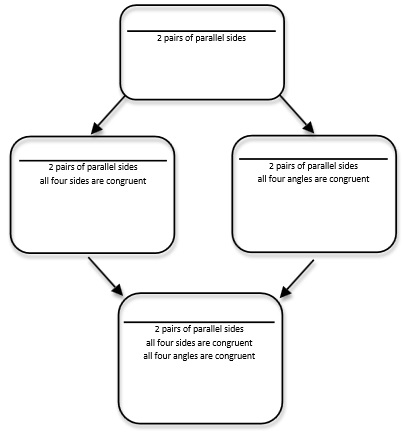
What do y'all detect about the relationships between quadrilaterals based on their characteristics and highlighted in the construction of the higher up chart?
How are the charts at the beginning and finish of this task related? What exercise they advise?
Symmetries of Regular Polygons
0
A line that reflects a figure onto itself is chosen a line of symmetry.
A figure that tin can exist carried onto itself by a rotation is said to take rotational symmetry.
A diagonal of a polygon is any line segment that connects non‐consecutive vertices of the polygon.
For each of the post-obit regular polygons, draw the rotations and reflections that conduct it onto itself: (be equally specific every bit possible in your descriptions, such as specifying the angle of rotation)
1. An equilateral triangle
2. A square
3. A regular pentagon
4. A regular hexagon
5. A regular octagon
6. A regular nonagon
What patterns practice you lot discover in terms of the number and characteristics of the lines of symmetry in a regular polygon?
What patterns do you notice in terms of the angles of rotation when describing the rotational symmetry in a regular polygon?
Symmetries of Quadrilaterals
0
A line that reflects a effigy onto itself is called a line of symmetry. A effigy that can exist carried onto itself past a rotation is said to have rotational symmetry.
Every 4‐sided polygon is a quadrilateral. Some quadrilaterals have additional properties and are given special names like squares, parallelograms and rhombuses. A diagonal of a quadrilateral is formed when opposite vertices are connected by a line segment. In this task you volition use rigid‐motility transformations to explore line symmetry and rotational symmetry in diverse types of quadrilaterals.
ane. A rectangle is a quadrilateral that contains four right angles. Is it possible to reflect or rotate a rectangle onto itself?
For the rectangle shown below, notice
•whatever lines of reflection, or
•any centers and angles of rotation
that will behave the rectangle onto itself.
Describe the rotations and/or reflections that bear a rectangle onto itself. (Be every bit specific as possible in your descriptions.)
ii. A parallelogram is a quadrilateral in which contrary sides are parallel. Is it possible to reflect or rotate a parallelogram onto itself? For the parallelogram shown below, observe
•any lines of reflection, or
•any centers and angles of rotation
that will carry the parallelogram onto itself.
Depict the rotations and/or reflections that carry a parallelogram onto itself. (Be as specific as possible in your descriptions.)
3. A rhomb is a quadrilateral in which all sides are congruent. Is it possible to reflect or rotate a rhomb onto itself?
For the rhombus shown beneath, detect
•any lines of reflection, or
•whatsoever centers and angles of rotation
that will carry the rhombus onto itself.
Describe the rotations and/or reflections that deport a rhombus onto itself. (Be as specific equally possible in your descriptions.)
iv. A square is both a rectangle and a rhombus. Is it possible to reverberate or rotate a square onto itself?
For the foursquare shown below, discover
•any lines of reflection, or
•any centers and angles of rotation
that will bear the foursquare onto itself.
Depict the rotations and/or reflections that carry a rhombus onto itself. (Exist as specific as possible in your descriptions.)
5. A trapezoid is a quadrilateral with one pair of reverse sides parallel. Is it possible to reflect or rotate a trapezoid onto itself?
Draw a trapezoid based on this definition. Then see if you tin can find
•any lines of symmetry, or
•any centers of rotational symmetry
that will deport the trapezoid you drew onto itself.
If you were unable to discover a line of symmetry or a center of rotational symmetry for your trapezoid,
see if yous can sketch a different trapezoid that might possess some type of symmetry.
Spring Yr
0
Part one
Carlos and Clarita are discussing their latest business venture with their friend Juanita. They accept created a daily planner that is both educational and entertaining. The planner consists of a pad of 365 pages bound together, i page for each day of the year. The planner is entertaining since images forth the lesser of the pages grade a flip‐book animation when thumbed through rapidly. The planner is educational since each folio contains some interesting facts. Each month has a different theme, and the facts for the month have been written to fit the theme. For example, the theme for January is astronomy, the theme for Feb is mathematics, and the theme for March is ancient civilizations. Carlos and Clarita accept learned a lot from researching the facts they have included, and they have enjoyed creating the flip‐volume animation.
The twins are excited to share the paradigm of their planner with Juanita before sending it to printing. Juanita, even so, has a major business. "Next twelvemonth is leap year," she explains, "you need 366 pages."
And then now Carlos and Clarita accept the dilemma of having to create an extra page to insert be tween February 28 and March 1. Hither are the planner pages they accept already designed.
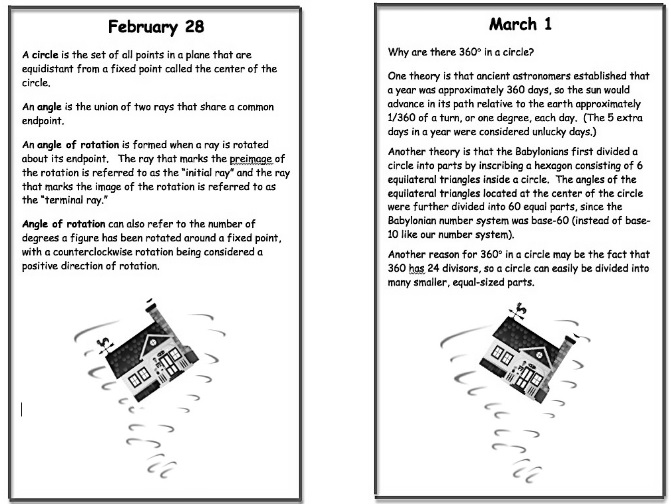
Since the theme for the facts for February is mathematics, Clarita suggests that they write formal definitions of the three rigid‐motion transformations they have been using to create the images for the flip‐book animation.
How would you complete each of the following definitions?
ane. A translation of a set of points in a plane . . .
2. A rotation of a set of points in a plane . . .
iii. A reflection of a fix of points in a plane . . .
4. Translations, rotations and reflections are rigid movement transformations because . . .
Carlos and Clarita used these words and phrases in their definitions: perpendicular bisector, centre of rotation, equidistant, bending of rotation, concentric circles, parallel, prototype, pre‐epitome, preserves distance and angle measures.
Revise your definitions so they as well use these words or phrases.
Role 2
In addition to writing new facts for February 29, the twins likewise need to add some other epitome in the middle of their flip‐volume blitheness. The blitheness sequence is of Dorothy'due south house from the Magician of Oz every bit information technology is being carried over the rainbow past a tornado. The firm in the Feb 28 drawing has been rotated to create the house in the March 1 drawing. Carlos believes that he can become from the February 28 drawing to the March 1 drawing past reflecting the February 28 drawing, and then reflecting it again.
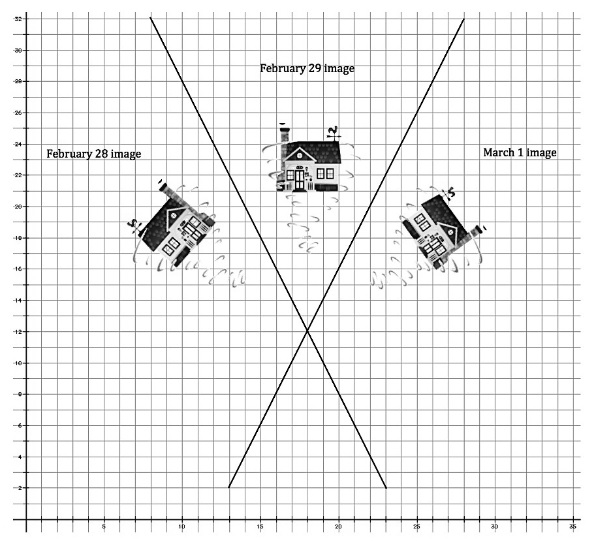
Verify that the epitome Carlos inserted betwixt the two images that appeared on February 28 and March 1 works as he intended. For example,
• What convinces you that the February 29 prototype is a reflection of the Feb 28 paradigm about the given line of reflection?
•What convinces you that the February 29 image is a reflection of the Feb 28 prototype nigh the given line of reflection?
•What convinces you that the two reflections together complete a rotation betwixt the February 28 and March 1 images?
Jump Frog
0
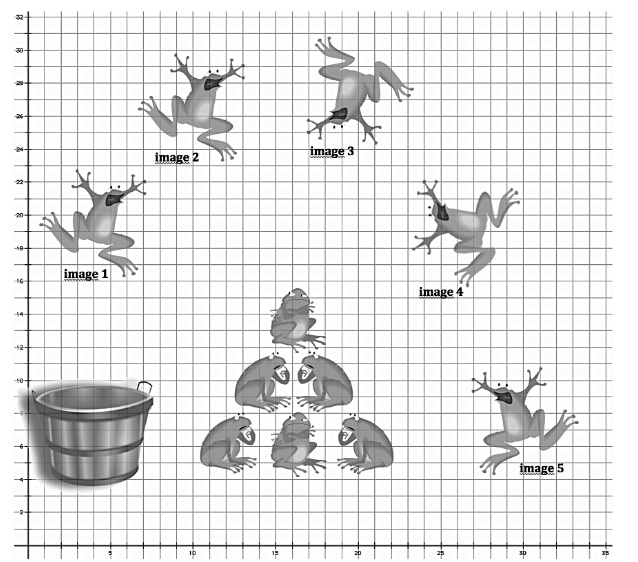
Josh is animative a scene where a troupe of frogs is auditioning for the Creature Channel reality show, "The Bayou's Got Talent". In this scene the frogs are demonstrating their "leap frog" acrobatics act. Josh has completed a few key images in this segment, and now needs to depict the transformations that connect various images in the scene.
For each pre‐image/image combination listed below, describe the transformation that moves the pre‐image to the last epitome.
• If you lot decide the transformation is a rotation, y'all will need to give the center of rotation, the direction of the rotation (clockwise or counterclockwise), and the measure of the angle of rotation.
• If you decide the transformation is a reflection, you volition need to requite the equation of the line of reflection.
• If you make up one's mind the transformation is a translation yous will need to depict the "rise" and "run" between pre‐epitome points and their corresponding prototype points.
• If y'all make up one's mind it takes a combination of transformations to get from the pre‐epitome to the final image, describe each transformation in the gild they would be completed.
| Pre-Image | Last Image | Description |
| image one | prototype 2 | |
| paradigm 2 | image 3 | |
| epitome three | epitome 4 | |
| image 1 | image five | |
| image 2 | prototype 4 |
Is It Right?
0
In Leaping Lizards y'all probably idea a lot about perpendicular lines, peculiarly when rotating the lizard virtually a 90° angle or reflecting the lizard beyond a line.
In previous tasks, we accept made the ascertainment that parallel lines have the same slope. In this job nosotros volition make observations near the slopes of perpendicular lines. Perhaps in Leaping Lizards you used a protractor or some other tool or strategy to assist you brand a right angle. In this job nosotros consider how to create a right angle by attention to slopes on the coordinate grid.
We begin by stating a fundamental idea for our piece of work: Horizontal and vertical lines are perpendicular. For example, on a coordinate grid, the horizontal line y = 2 and the vertical line ten = 3 intersect to form four right angles.
Only what if a line or line segment is not horizontal or vertical?
How do we decide the slope of a line or line segment that will exist perpendicular to it?
Experiment one
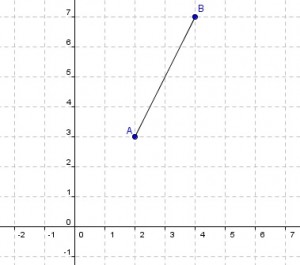
i. Consider the points A (two, 3) and B (4, seven) and the line segment, AB, between them.
What is the slope of this line segment?
2. Locate a tertiary point C (x, y) on the coordinate grid, and so the points A (2, 3), B(4, seven) and C (x, y) course the vertices of a
right triangle, with AB as its hypotenuse.
3. Explicate how you know that the triangle you formed contains a right angle?
4. Now rotate this right triangle 90° about the vertex point (2, 3). Explain how you know that you have rotated the triangle 90°.
5. Compare the gradient of the hypotenuse of this rotated right triangle with the slope of the hypotenuse of the pre‐image. What practice y'all notice?
Experiment 2

Repeat steps i‐5 to a higher place for the points A (2, 3) and B (five, iv).
Leaping Lizards!
0
Animated films and cartoons are now usually produced using calculator engineering science, rather than the hand-fatigued images of the past. Computer animation requires both artistic talent and mathematical knowledge.
Sometimes animators want to motion an epitome effectually the computer screen without distorting the size and shape of the paradigm in whatsoever style. This is done using geometric transformations such every bit translations (slides), reflections (flips), and rotations (turns) or peradventure some combination of these. These transformations need to be precisely defined, and then there is no doubt nearly where the last image volition end up on the screen.
So where practice yous remember the lizard shown on the grid on the post-obit page will end up using the following transformations? (The original lizard was created past plotting the following anchor points on the coordinate filigree and so letting a estimator plan describe the cadger. The anchor points are always listed in this order: tip of nose, center of left front foot, belly, center of left rear foot, point of tail, heart of rear right foot, back, eye of front right human foot.)

Original cadger ballast points:
{(12,12),(15,12), (17,12), (19,ten),(19,14),(20,thirteen), (17,15), (xiv,16)}
Each statement beneath describes a transformation of the original cadger.
Exercise the following for each of the statements:
•plot the anchor points for the lizard in its new location
•connect the preimage and image anchor points with line segments, or round arcs, whichever best illustrates the human relationship between them
Lazy Lizard
Translate the original lizard so the point at the tip of its nose is located at (24,20), making the lizard appears to be sunbathing on the stone.
Lunging Cadger
Rotate the lizard xc° well-nigh point A(12,7) so information technology looks similar the lizard is diving into the puddle of mud.
Leaping Lizard
Reflect the lizard about given line y = x/2 + 16 so it looks like the lizard is doing a back flip over the cactus.

So,
Who to work with? You volition work with your elbow partner, but each one of you will have to turn in the assignment. I Will ONLY Check ONE OF THEM, so make certain that you agree with your partners' work!
What materials do I need? The GeoGebra file "Leaping Lizards" has been shared with you lot in your Bulldoze/Math1/Module 6 folder.
What do I need to turn in? You will have to turn in
– 3 GeoGebra files titled Lazy Lizard, Lunging Lizard, and Leaping Lizard. Share those 3 files with me. Retrieve to name the files: Math1_PeriodX_Last Name_Title.
– A presentation titled "Conclusions" for each one of the three transformations. You lot tin can use the following sentences frames:
- In _________________ the best way to illustrate the relationship between preimage and prototype is _______________________, but in _________________________________ the all-time way is________________________________________.
- In _______________ connecting the points shows _____________________________, which means that __________________ _________________________ is always the same.
I recommend you to take a wait at Prezi or Thinglink to create your presentations.
How am I going the be given a grade? Here is the rubric for the activity:
| 1 point | ii points | 3 points | 4 points | |
| Lazy Lizard | Translation is shown | Translation is shown, and some image points are shown | Translation is shown, and all preimage/paradigm points are connected | Translation is shown, all preimage/paradigm points are continued correctly |
| Lunging Lizard | Rotation is shown | Rotation is shown, and some image points are shown | Rotation is shown, and all preimage/epitome points are continued | Rotation is shown, all preimage/image points are connected correctly |
| Leaping Cadger | Reflection is shown | Reflection is shown, and some epitome points are shown | Reflection is shown, and all preimage/image points are connected | Reflection is shown, all preimage/epitome points are connected correctly |
| Conclusions | Some coclusions are extracted | Some coclusions are extracted, and justified | Coclusions for all three transformations are extracted, and some justified correctly | Coclusions for all three transformations are extracted, and justified correctly |
Source: https://blocs.xtec.cat/mriglesiasmathclass/
Posted by: smithbutch1974.blogspot.com

0 Response to "Would Dots Moving Across A Screen Be Considered Congruent Or Similar What Is Slope In Animation"
Post a Comment